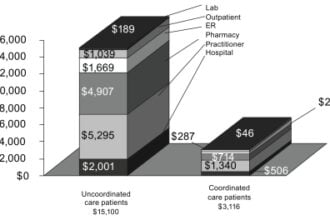In the 12 years since our government acknowledged we had a problem with racial disparities in health care, we’ve made significant progress in reducing them. Steep declines in the prevalence of cigarette smoking among African Americans have narrowed the gap in lung cancer death rates between them and whites, for example. Inner city kids have better food choices at school.
In the 12 years since our government acknowledged we had a problem with racial disparities in health care, we’ve made significant progress in reducing them. Steep declines in the prevalence of cigarette smoking among African Americans have narrowed the gap in lung cancer death rates between them and whites, for example. Inner city kids have better food choices at school. The 3-decade rise in obesity rates, steepest among minorities, has leveled off.
Still, racial disparities persist across the widest possible range of health services and disease states in our country. The racial gap in colorectal cancer mortality has widened since the 1980s. Overall cancer death rates are 24% higher among African Americans. Sixteen percent of African American adults and 17% of Hispanic adults report their health to be fair or poor, whereas only 10% of white American adults say that. The number of African Americans and Hispanics who report having access to a primary care physician is 30-50% lower than white folks who have one.
How can EMRs Help?
Many studies that rely on EMRs for data collection or care coordination have shown them to have great potential as tools that can reduce racial disparities in health care. For example, a 2009 study showed that post-market surveillance using patient data stored in an EMR could have detected cardiovascular complications from the diabetes drug, Avandia much faster than traditional methods. That’s a plus because African Americans and Hispanics are disproportionately affected by diabetes. Another study showed that patient data from EMRs could identify patients at high risk for domestic abuse, which is more common in some minority populations. A third study showed that EMRs improved care coordination for patients with kidney failure, a condition that disproportionately affects African Americans.
Some of the Federal government’s Meaningful Use criteria may also reduce these disparities, once they fully take effect. The requirement that providers use clinical decision support tools embedded within EMRs holds promise in this regard. CDS tools whose development was underwritten by the Agency for Healthcare Research and Quality incorporate care management strategies designed specifically for minority populations, for example. In addition, Meaningful Use also requires providers to record patient demographic information in the EMR, and this development will likely increase the research value of the patient data contained in these systems.
But There is a Problem
Unfortunately, the National Ambulatory Medical Care Survey suggests that EMR adoption rates are lower among providers who serve minority populations. A study by Jha and colleagues confirmed these findings and also demonstrated that hospitals which served Hispanic and African American patients provided lower quality care. However, among the disproportionate-share hospitals that did use EMRs in Jha’s study, the quality gap disappeared. Jha’s group concluded that EMRs helped mitigate quality issues in hospitals where poor people and minorities received care.
Studies like these prompted David Blumenthal, the National Coordinator for HIT at the time, to implore EMR vendors to help assure that the financial incentives associated HITECH would not create a “digital divide,” in which disproportionate care hospitals fell further behind their brethren.
“It is absolutely necessary that the leading EHR vendors work together, continuing to provide EHR adoption opportunities for physicians and other healthcare providers working within underserved communities of color,” Blumenthal said.
So Where We Stand Now?
So far as I know, only 2 vendors have stepped up to the plate in this regard (please let me know of others!). The first is Practice Fusion, which has a longstanding policy of partnering with free clinics, non-profits and community health organizations to help spread the benefits inherent to EMRs to patients, regardless of their ability to pay. Practice Fusion provides an ad-free version of its EMR along with specialized training, customizations, hardware guidance and implementation assistance to qualified non-profit organizations (Disclosure: I served for 2 years as Sr. VP Clinical Affairs and own stock in this company).
More recently, Quest Diagnostics rolled-out a new initiative in conjunction with HHS’ Office of Minority Health to help improve EMR adoption among small healthcare practices serving medically underserved and minority populations in the Houston area.
Quest is waiving 85% of the cost of EMR licenses for its cloud-based Care360 EMR for 75 qualifying practices (Stark Laws require some payment, according to Quest). The offer includes subscription fees and assistance with education and training.
These companies are to be congratulated. More vendors should step up as well. EMRs hold great promise as tools to reduce racial disparities in health care in our country.







